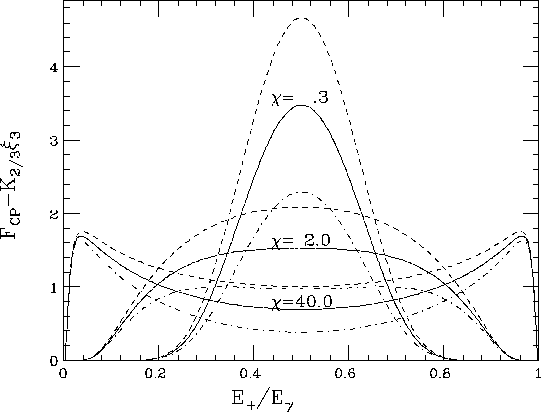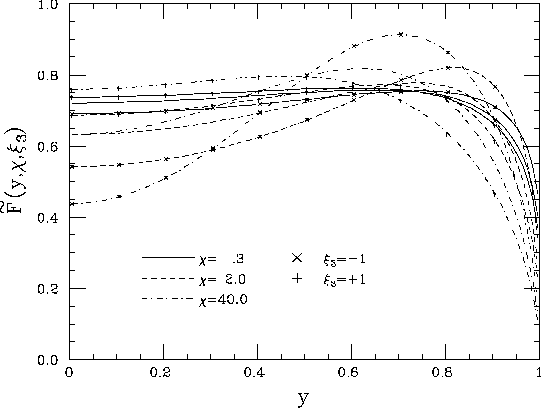where
When a high energy photon goes through a strong transverse field,
it can create a real electron-positron pair. This process is known
as `coherent pair creation' and is characterized by the parameter
![]()
where ![]() is the energy of the initial photon.
(
is the energy of the initial photon.
(![]() and
and ![]() are defined in eq.(84).)
The probability of the process is exponentially small
(
are defined in eq.(84).)
The probability of the process is exponentially small
(![]() ) when
) when ![]() is small.
is small.
Let us denote the energy and polarization vector of initial photon
and final positron/ electron by
![]() ,
, ![]() (
(![]() ),
), ![]() , and
, and ![]() .
The transition rate is obtained by the following replacement in the formula
(92):
.
The transition rate is obtained by the following replacement in the formula
(92):

Ignoring the terms related to the polarization correlation between the
final electron and positron, we obtain

where ![]() is defined as
is defined as
![]()
![]() is the modified Bessel function and
is the modified Bessel function and ![]() is defined in
eq.(87). Their arguments are
is defined in
eq.(87). Their arguments are ![]() defined in eq.(99).
The transition rate summed over the final polarization is
defined in eq.(99).
The transition rate summed over the final polarization is


Figure 9: Function ![]() for three values of
for three values of ![]() . The solid, dotdash and dashed
curves are for
. The solid, dotdash and dashed
curves are for ![]() , 1, -1, respectively.
The curves for
, 1, -1, respectively.
The curves for ![]() are normalized such that
are normalized such that
![]() , and those for
, and those for ![]() are drawn with the same scale as the corresponding
are drawn with the same scale as the corresponding ![]() curves.
curves.
The function ![]() is plotted in Fig.9
as a function of
is plotted in Fig.9
as a function of ![]() .
.
1ex
The total rate for given ![]() is approximately
is approximately
![]()
where
![]()
In order to make the spectrum function flatter, CAIN introduces the
variable y (-1<y<1) instead of ![]() (0<x<1):
(0<x<1):

The spectrum function with respect to y then becomes
![]()
where y/2 is used because the range of y is 2.
The constant
![]()
is chosen so that ![]() for any
for any ![]() .
.
![]() is plotted in Fig.10.
is plotted in Fig.10.

Figure 10: Function ![]() as a function of y
for three values of
as a function of y
for three values of ![]() =0.3, 2, 40 and for
=0.3, 2, 40 and for ![]() .
The parameter
.
The parameter ![]() is indicated by the line mode and
is indicated by the line mode and
![]() is by crosses (no cross for
is by crosses (no cross for ![]() ).
).
Now, the event generation goes as
